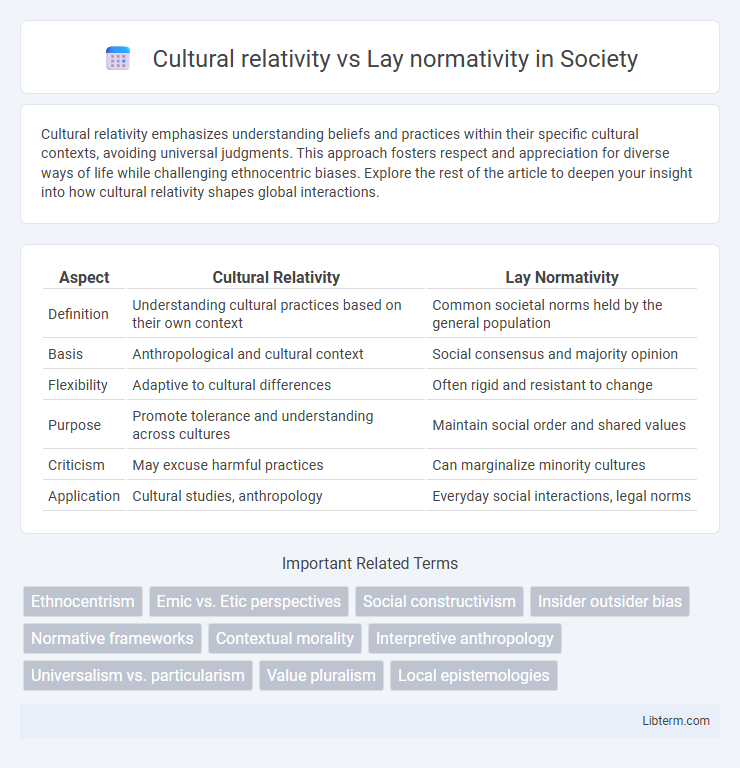Cultural relativity emphasizes understanding beliefs and practices within their specific cultural contexts, avoiding universal judgments. This approach fosters respect and appreciation for diverse ways of life while challenging ethnocentric biases. Explore the rest of the article to deepen your insight into how cultural relativity shapes global interactions.
Table of Comparison
| Aspect | Cultural Relativity | Lay Normativity |
|---|---|---|
| Definition | Understanding cultural practices based on their own context | Common societal norms held by the general population |
| Basis | Anthropological and cultural context | Social consensus and majority opinion |
| Flexibility | Adaptive to cultural differences | Often rigid and resistant to change |
| Purpose | Promote tolerance and understanding across cultures | Maintain social order and shared values |
| Criticism | May excuse harmful practices | Can marginalize minority cultures |
| Application | Cultural studies, anthropology | Everyday social interactions, legal norms |
Introduction to Cultural Relativity and Lay Normativity
Cultural relativity emphasizes understanding beliefs and practices within their own cultural contexts, avoiding ethnocentric judgments. Lay normativity refers to the everyday moral standards and social norms shaped by the common experiences of individuals in a society. Distinguishing these concepts reveals how cultural perspectives influence normative frameworks and ethical evaluations.
Defining Cultural Relativity
Cultural relativity centers on understanding beliefs, values, and practices within the context of a specific culture, emphasizing that no culture is inherently superior to another. It asserts that moral judgments and social norms must be evaluated based on the cultural framework from which they originate, avoiding ethnocentric bias. This perspective contrasts with lay normativity, which relies on everyday, often unexamined, moral intuitions and assumptions common in broader society.
Understanding Lay Normativity
Lay normativity refers to the informal, everyday standards and expectations that guide behavior within a community, distinct from formal ethical theories. It emphasizes how individuals interpret and apply social norms based on shared cultural practices and lived experiences. Understanding lay normativity provides insight into how moral judgments emerge naturally in social contexts, often differing from culturally relative frameworks that prioritize overarching cultural value systems.
Historical Contexts of Both Concepts
Cultural relativity emerged in the early 20th century through anthropologists like Franz Boas, emphasizing understanding social practices within their historical and cultural contexts to avoid ethnocentrism. Lay normativity, rooted in everyday moral judgments and common sense, reflects how non-experts apply normative standards shaped by their historical and social experiences. The historical divergence highlights cultural relativity's academic quest for objectivity contrasted with lay normativity's basis in lived, contextualized social norms.
Key Differences Between Cultural Relativity and Lay Normativity
Cultural relativity emphasizes understanding beliefs and practices within their cultural contexts without judgment, prioritizing ethnographic accuracy and respect for diversity. Lay normativity, however, reflects everyday societal norms shaped by common moral intuitions and widely shared values, often guiding social behavior informally. The key difference lies in cultural relativity's descriptive, non-evaluative stance contrasted with lay normativity's prescriptive role in reinforcing community standards.
Interplay and Overlap: Where They Converge and Diverge
Cultural relativity emphasizes understanding behaviors and beliefs within specific cultural contexts, while lay normativity reflects the everyday moral judgments held by ordinary people in diverse societies. Their interplay occurs when cultural norms shape lay perceptions of right and wrong, revealing points of convergence in shared values across cultures and divergence in culturally specific moral codes. Examining where these frameworks overlap highlights how societal norms influence individual ethics and underscores challenges in applying universal moral standards.
Cultural Relativity in Everyday Life
Cultural relativity in everyday life emphasizes understanding behaviors, customs, and values within their specific cultural contexts rather than judging them by external standards. This perspective fosters empathy and reduces ethnocentric bias by recognizing that what is considered normative or moral varies across societies. It encourages adapting social interactions and communication to respect diverse cultural frameworks, promoting harmony in multicultural environments.
Lay Normativity’s Influence on Social Behavior
Lay normativity significantly shapes social behavior by establishing unwritten rules and expectations within everyday interactions, often reflecting dominant cultural values without formal codification. This grassroots norm enforcement influences conformity, social cohesion, and the negotiation of moral standards, highlighting the dynamic between individual actions and collective societal judgments. Understanding lay normativity's role in social behavior reveals how informal social pressures impact behavior regulation beyond formal legal or institutional frameworks.
Challenges and Criticisms of Each Perspective
Cultural relativity faces challenges in addressing practices that violate universal human rights, making it difficult to criticize harmful customs without imposing external values. Lay normativity often encounters criticism for its subjective and variable standards, which can lead to inconsistent moral judgments and overlook cultural diversity. Both perspectives struggle to balance respect for cultural differences with the need for coherent ethical frameworks in global contexts.
Implications for Cross-Cultural Understanding
Cultural relativity emphasizes understanding behaviors and beliefs within their specific cultural contexts, which fosters empathy and reduces ethnocentric judgments in cross-cultural interactions. Lay normativity, referring to everyday common-sense norms, can create barriers when individuals impose their own cultural standards on others, leading to misunderstandings and conflicts. Recognizing the distinction between culturally relative practices and universal normative assumptions enhances communication and cooperation across diverse societies.
Cultural relativity Infographic

 libterm.com
libterm.com